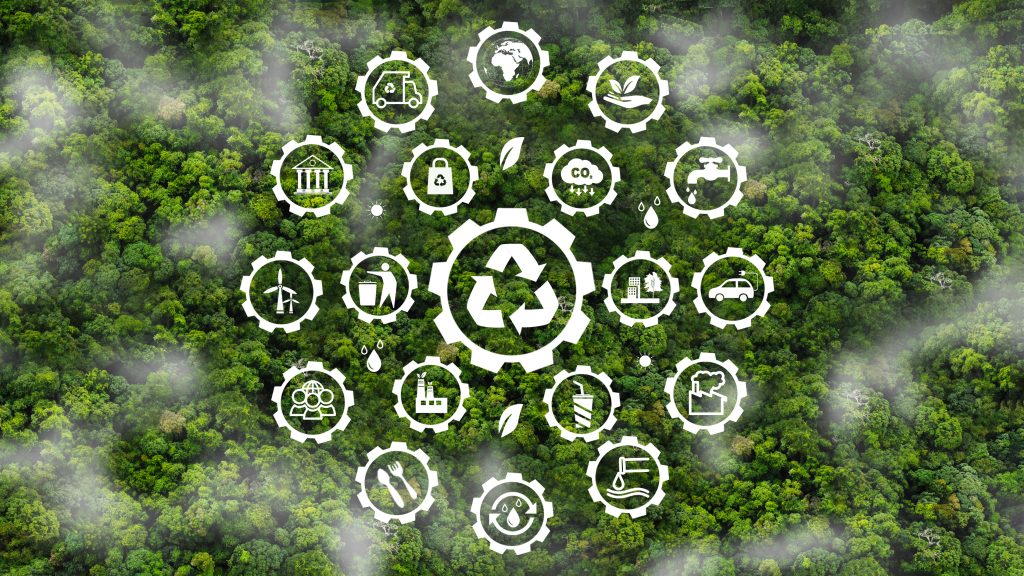
Do you remember the first time you made a small change to help the planet? Maybe it was switching to reusable bags, turning off lights when you left a room, or using a refillable water bottle. Small steps can feel simple, yet they add up to big changes over time. In a contact center, just like in everyday life, these little steps toward eco-friendly practices can make a huge difference. Each one is like planting a tree—small actions that contribute to a growing forest of positive impact.
Why should you care about this in your contact center? The truth is that 78% of your customers believe that sustainability is important. Furthermore, 66% of them consider sustainability when making a purchase. And it’s not just consumers. Your employees also care. A recent survey found that 69% of employees want their employer to reduce their carbon footprint and follow eco-friendly practices. By adopting integrity-driven practices you can not only protect the environment but also win their trust. It’s good for our planet, and it’s good for your business.
That’s the “why.” But the harder part is the “how.” How can you do it? I know it can feel daunting and expensive. But it doesn’t have to be that way. We’ve done the research and put together this comprehensive guide for you. What will we consider? 4 integrity-driven practices for eco-friendly customer support that focus on cost savings, efficiency, and the environment. Each of these is achievable, impactful, and will help you to make a difference.
Are you ready to lead the way in sustainability?
Practice #1: Adopt Energy-Efficient Technologies
Let’s start with one of the most effective steps: adopting energy-efficient technologies. Think of this as upgrading from an old car to a hybrid—smoother, cleaner, and less money on fuel. For contact centers, this “fuel” is energy, and by using smarter technology, we cut down on waste and keep costs under control.
Why It Matters
Energy-efficient solutions are a win-win for contact centers. They reduce power use, save money, and shrink your environmental footprint. Using cloud computing and efficient hardware also supports smoother operations, making daily tasks easier for your team.
How to Get Started
- Switch to Cloud-Based Systems Cloud computing reduces the need for on-site servers, which consume a lot of power. By moving data and processes to the cloud, your center can rely on shared data centers designed to run more efficiently. Plus, cloud systems are typically better optimized for data security and scalability.
- Upgrade to Energy-Efficient Hardware Look for energy efficient equipment, which meets strict efficiency guidelines. By swapping outdated hardware for newer, energy-efficient computers, monitors, and servers, you’ll lower your energy costs while also improving performance.
- Install Smart Lighting and HVAC Systems Smart lights and programmable thermostats can make a big impact. Motion-sensor lighting turns lights off automatically when rooms are empty, and smart thermostats keep heating and cooling energy use in check.
Real Impact
Consider this: if every contact center took these steps, it would be like planting millions of trees each year. Each watt saved counts. You’ll be helping build a greener world while also lightening your budget.
By focusing on energy-efficient technologies, your contact center can take meaningful steps toward sustainability that helps both the environment and your bottom line. Ready to save energy and make an impact? Start small, and let the results speak for themselves.

Practice #2: Embrace Remote and Hybrid Work Models
Next, let’s talk about one of the simplest ways to go green: remote and hybrid work. Imagine how much energy is saved just by working from home—no commuting, no extra office lights, and fewer daily power needs. For a contact center, these eco-friendly practices can make a big difference.
Why It Matters
Allowing remote or hybrid work not only cuts down on energy and emissions but also improves work-life balance. It’s a growing trend for a reason, despite some return to office initiatives. Plus, it shows your employees that you’re committed to both sustainability and their well-being. Happy employees are productive employees, and eco-conscious employees feel that they are doing good for our planet.
How to Get Started
Adopting remote work doesn’t have to be all or nothing. Here are three easy ways to implement it sustainably:
- Start with Hybrid Schedules
Offer a few days a week for remote work. This balances the benefits of in-office collaboration with the energy savings of working from home. Hybrid models are popular because they offer flexibility without sacrificing teamwork. - Provide Remote-Ready Tools
Ensure your team has access to cloud systems and collaboration tools so they can work effectively from anywhere. Video conferencing, secure file-sharing platforms, knowledge management tools, and cloud-based software help keep things running smoothly. - Track and Optimize Remote Benefits
Use software to measure reduced carbon emissions from commuting and lower energy usage. For example, Code Carbon is an open-source tool to track emissions from compute, and the Commuter Carbon Calculator from the reductions in travel. Showing your team the impact of their remote work reinforces the benefits and encourages more sustainable choices.
Real Impact
Think of a typical workday. Now imagine that half of your team works from home. Not only do you cut down on your office’s energy usage, but you also reduce pollution from employee commutes. Even a small reduction in office occupancy can lower your carbon footprint.
Adopting a remote and hybrid work model empowers your team to help the planet one workday at a time. And, as a contact center focused on integrity, you’ll be building a work culture that’s both sustainable and forward-thinking.
Practice #3: Optimize Routing and Workflows
Let’s dive into an often overlooked but powerful way to go green: optimizing routing and workflows. Think of it like using a GPS that knows the fastest route with zero traffic—it saves time, energy, and resources. In a contact center, better routing and smart workflows do the same for your support team and customers.
Why It Matters
Efficient routing reduces the time customers spend waiting and minimizes the number of call transfers. This not only saves energy but also improves customer satisfaction. When you add in smart workflows, you can streamline processes even further, so your team can handle more support with less hassle.
How to Get Started
Here’s how to make call routing and AI workflows work for your contact center:
- Use Intelligent Routing
Intelligent routing directs customers to the right agent or resource immediately, based on their needs. This means fewer transfers and shorter call times. A well-optimized routing system is like having a direct path to the solution. - Incorporate AI-Powered Self-Service Options
Self-service options, like AI chatbots, can handle common questions, saving agents for more complex issues. A simple FAQ or guided AI chat can be as effective as a quick shortcut to the right answer. - Analyze and Refine Workflow Efficiency
Use analytics to review how calls flow through your system. Find bottlenecks or steps that slow down response times. This is a continuous process—fine-tuning for maximum efficiency helps reduce wasted energy.
Real Impact
Imagine the resources saved when calls go directly to the right place. By using optimized routing and workflows, your contact center can serve customers faster, save energy, and reduce the workload on your agents. It’s a bit like setting up a more organized traffic system—fewer stops, less waiting, and a smooth experience from start to finish.
Efficient workflows don’t just make a difference in your team’s day—they reflect your commitment to eco-friendly, integrity-driven support. With these small steps, your center becomes part of a larger solution that helps both people and the planet.
Tip: Take Advantage of Smart AI with LivePerson’s Conversational Cloud. Looking to take your routing and workflows to the next level? LivePerson’s Conversational Cloud offers powerful AI tools that automate common tasks and connect customers to the right agents or solutions. Ready to investigate what this solution can do for you? Contact us today for a free consultation. As expert system integrators with over 18 years of experience, we are well positioned to help you get started with this incredible tool.

Practice #4: Implement Waste Reduction Initiatives
Reducing waste is one of the most visible ways to make an impact. Imagine the difference between a messy, paper-filled workspace and a clean, efficient one—it’s a lot easier to work with less clutter and waste. For a contact center, small changes in everyday habits can quickly add up, making your workplace more sustainable and organized.
Why It Matters
Waste reduction isn’t just good for the environment; it also improves team morale and shows clients that your customer service team values responsibility. Whether it’s paper, packaging, or energy waste, reducing what you use and throw away is a practical, integrity-driven approach to sustainability.
How to Get Started
Starting a waste reduction initiative doesn’t have to be difficult. Here are four simple steps that every contact center can take:
- Go Paperless with Digital Documentation
Switch to digital forms, contracts, and reports to cut down on paper waste. With the right software, even signatures can be done electronically, which saves both paper and time. - Introduce Office Recycling Programs
Set up designated recycling bins for paper, plastic, and electronics. Clear labeling and convenient placement make recycling easy for everyone on the team. - Eliminate Single-Use Items
Encourage reusable items, like mugs, water bottles, and utensils, instead of disposable ones. Even small swaps can reduce a surprising amount of waste over time. - Reuse and Repurpose Office Supplies
For items like folders, binders, and boxes, reuse what you can. Encourage your team to get creative with repurposing supplies rather than tossing them out.
Real Impact
Imagine if every desk in your contact center was clear of unnecessary paper and clutter. Not only would it make the space more productive, but it would also reduce your center’s footprint. Each piece of paper saved or item reused brings you closer to a more eco-friendly workplace.
By focusing on waste reduction initiatives, your contact center shows a commitment to sustainability that goes beyond words. Small actions, taken consistently, build up over time. It’s an approach that’s not only practical but also a great example of integrity in action.
Conclusion: Making a Lasting Impact Through Eco-Friendly Choices
These integrity-driven practices may seem small, but together they build a powerful, sustainable foundation for your eco-friendly customer service. Imagine your contact center as a thriving garden—each eco-friendly choice is like planting a seed that grows into lasting impact. By focusing on energy-efficient technology, remote work, optimized routing and workflows, and waste reduction, you’re creating a workplace that respects both people and the planet.
Why It Matters for the Long Run
Sustainable practices aren’t just good for today—they set your customer service team up for a more resilient future. With every step, you’re reducing your environmental footprint and contributing to a healthier world. It’s a cycle of positive change, where careful decisions improve both customer experiences and workplace morale.
When your team and customers see your commitment, it will build their trust in you and your dedication to doing business responsibly. It’s not just good for our planet, it’s good for your business as well.
Stay Updated on the Latest in Customer Experience!
Want to keep your contact center at the forefront of your industry? Subscribe to the CBA blog for insights, tips, and industry trends that help you create a better, more efficient customer experience. Join us on the journey to customer satisfaction—delivered straight to your inbox!


